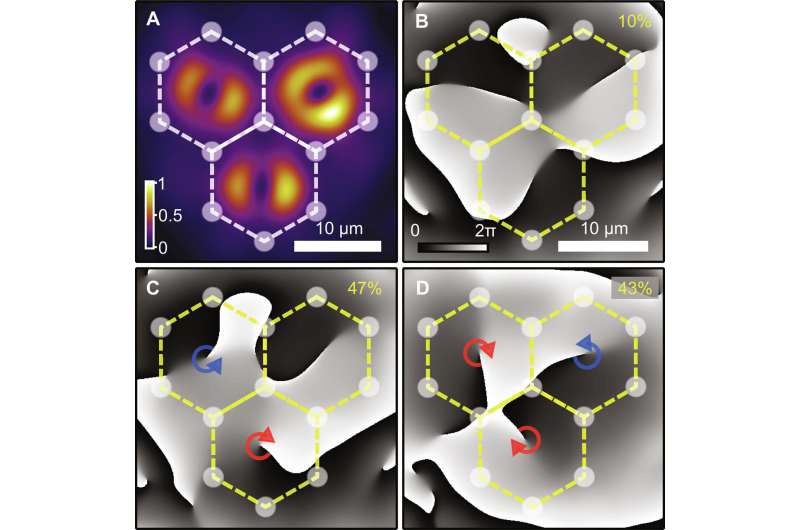This article has been reviewed according to Science X's editorial process and policies. Editors have highlighted the following attributes while ensuring the content's credibility:
fact-checked
peer-reviewed publication
trusted source
proofread
Researchers demonstrate spontaneous synchronization of quantum vortices in semiconductor microcavities

Researchers from Skoltech, Universitat Politècnica de València, Institute of Spectroscopy of RAS, University of Warsaw, and University of Iceland have demonstrated the spontaneous formation and synchronization of multiple quantum vortices in optically excited semiconductor microcavities.
They showed that polariton quantum vortices formed in the neighboring cells of optically generated lattices tend to have an opposite topological vortex charge, i.e., the vortices are "antiferromagnetically coupled."
The work has been published in Science Advances.
Optically structured artificial lattices made up of coupled polariton vortices are a promising new platform for the study and simulation of condensed matter systems by replacing spin angular momentum with orbital angular momentum of the polariton condensate.
The dynamics of quantum vortices in exciton-polariton systems have been studied for a long time using a variety of optical excitation techniques. However, extended two-dimensional lattices of phase-locked quantum vortices have not been demonstrated so far in such a driven-dissipative system.
In this work, the authors managed to create, by optical means, a triangular lattice with 22 cells possessing trapped polariton condensates, each carrying a single-charge vortex.

How to excite the lattice of quantum vortices and make them interact?
All experiments were carried out at Skoltech, in the Photonics Center's Hybrid Photonics Laboratory, led by Professor Pavlos Lagoudakis, the Institute's vice president for photonics.
In the experiments, the researchers used a semiconductor planar microcavity—two highly reflective mirrors, forming a resonator, with InGaAs quantum wells sandwiched in between. This results, under certain conditions (so called strong-light matter coupling regime), in the formation of quasiparticles called exciton–polaritons or microcavity polaritons—coupled states of the excitons in quantum wells and the confined cavity photons.
"We optically excited a semiconductor microcavity sample with a patterned laser beam using our technique of spatial light modulation, which we have mastered recently with our colleagues from the University of Southampton. This technique allowed us to shape the laser beam into an array of tightly focused Gaussian beams, arranged in hexagonal lattice," said Skoltech Assistant Professor, Sergey Alyatkin, the first author of the paper.
"Then we varied the lattice parameters and found that for a small lattice constant above some critical excitation power, the polaritons condense inside the cells of the lattice. First, we checked experimentally what happens in a single cell. The trapped condensate occupied the vortex states with almost equal probabilities for the vortex (topological charge of +1) and antivortex (topological charge of -1).
"However, in a pair of neighboring cells, the vortices interact and form a stable solution with opposite topological charge in each cell, always forming either vortex–antivortex or antivortex–vortex pair. Next, we studied the physics of the condensates in a triangular three-cell structure, and next a much larger triangular lattice of vortices. The most difficult part for me was to statistically analyze a huge experimental dataset to support our claims."
"At this point, we suspected that the vortices were not only synchronizing in small frustrated clusters, but instead showed a signature of extended antiferromagnetic order in the implemented triangular lattice," added theoretician Dr. Helgi Sigurðsson from the University of Warsaw.
"In order to verify this, we measured the vortex charge (orbital angular momentum) of each condensate across all lattice cells over multiple individual-and-independent realizations of the lattice, and checked for correlations with the low-energy configurations of the famous Ising spin Hamiltonian.
"We found that the observed orbital angular momentum in the stable solutions of our vortex lattice correlated significantly with the low-energy solutions of antiferromagnetically coupled Ising spins. Our results underline that by projecting the complicated dynamics of one system onto another, we can find peculiar similarities."
More information: Sergey Alyatkin et al, Antiferromagnetic Ising model in a triangular vortex lattice of quantum fluids of light, Science Advances (2024). DOI: 10.1126/sciadv.adj1589
Journal information: Science Advances
Provided by Skolkovo Institute of Science and Technology





















